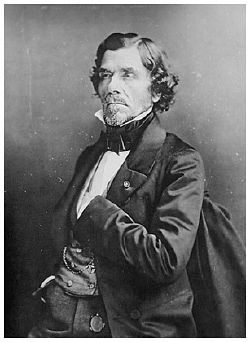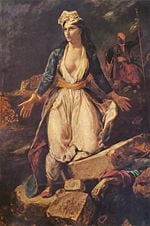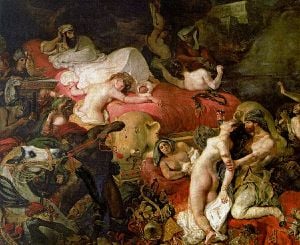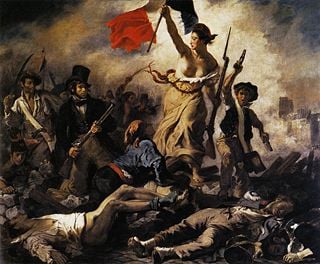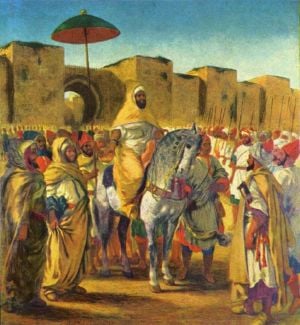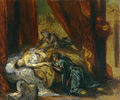Eugene Delacroix
| Ferdinand Victor Eugène Delacroix |
|---|
Eugène Delacroix (portrait by Nadar)
|
| Born |
| April 26, 1798 [A[Charenton]]-Saint-Maurice, Île-de-France, France |
| Died |
| ugust 13, 1863 Paris, France |
Ferdinand Victor Eugène Delacroix (April 26, 1798 – August 13, 1863) was the most important of the French Romantic painters. Delacroix's use of expressive brushstrokes and his study of the optical effects of color profoundly shaped the work of the Impressionisms, while his passion for the exotic inspired the artists of the Symbolist movement.
As an innovative artist, who was nevertheless still steeped in the tradition of the classics, he served as inspiration to younger artists. Additionally, his remarkable use of color was later to influence even modern artists such as Pablo Picasso. Paul Cezanne speaking of Delacroix's far reaching legacy, once remarked, "We are all in Delacroix." [1]
A skillful writer, his journals have also been recognized as an important record of the artists' life and work during this era.
Early life and art education
Delacroix was born at Charenton-Saint-Maurice, Val de Marne département, in the Île de France région near Paris, France.
It has often been theorized that his father, Charles Delacroix, was infertile at the time of Eugène's conception and that his real father was the French diplomat Talleyrand, whom he resembled in appearance as an adult. [1]
His early education was at the Lycée Louis-le-Grand, where he steeped himself in the classics and won awards for drawing. In 1815 he began his training with Pierre-Narcisse Guérin in the neoclassical style of Jacques-Louis David, but he was strongly influenced by the more colorful and rich style of the Flemish painter Peter Paul Rubens (1577-1640) and fellow French artist Théodore Géricault (1791-1824) whose works marked an introduction to romanticism in art.
In 1822, his first major painting, The Barque of Dante, was accepted by the Paris Salon and
Chios and Missolonghi
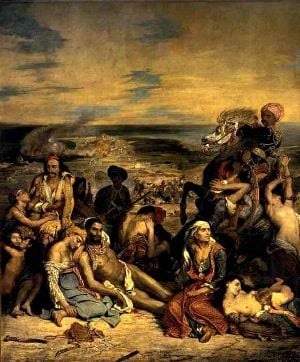
two years later, at the young age of he earned recognition for his Massacre at Chios. Although a controversial picture, due to its brutality, it was also well regarded by many French people who sympathized with the Greeks, who had been in their war of independence from the Turks. Greece was looked to by many at the time, in reverence, as the birthplace of classic tradition in art and literature. The painting of the Massacre at Chios (also called Massacre at Scio, French: Scènes des massacres de Scio), shows sick, dying Greek civilians about to be slaughtered by the Turks.
Delacroix was quickly recognized as a leading painter in the new Romantic style, and the picture was bought by the state. His depiction of suffering was controversial however, as there was no glorious event taking place, no patriots raising their swords in valour as in David's Oath of the Horatii; there was only a disaster. Many critics deplored the painting's despairing tone; one called it "a massacre of art." [2] The pathos in the depiction of an infant clutching its dead mother's breast had an especially powerful effect, although this detail was condemned as unfit for art by Delacroix's critics.
Delacroix painted a second painting in support of the Greeks in their war of independence in 1827. Greece Expiring on the Ruins of Missolonghi shows a woman in Greek costume with her arms raised in a powerless gesture toward the horrible scene: the suicide of the Greeks, who chose to kill themselves and destroy their city rather than surrender to the Turks. A hand is seen at the bottom, the body having being crushed by the rubble of the city. The whole picture serves as a monument to the people of Missolonghi and to the idea of freedom against tyrannical rule. This event interested Delacroix not only for his sympathies with the Greeks, but also because the poet Lord Byron, whom Delacroix greatly admired, had died there.
Death of Sardanapalus
Delacroix's painting of the death of the Assyrian king Sardanapalus shows an emotionally stirring scene alive with beautiful colours, exotic costumes and tragic events. The Death of Sardanapalus depicts the besieged king watching impassively as guards carry out his orders to kill his servants, concubines and animals. The literary source is a play by Byron, although the play does not specifically mention any massacre of concubines.
Sardanapalus' attitude of calm detachment is a familiar pose in Romantic imagery in this period in Europe. The painting, which was not exhibited again for many years afterward, has been regarded by some critics as a gruesome fantasy involving death and lust. Especially shocking is the struggle of a nude woman whose throat is about to be cut, a scene placed prominently in the foreground for maximum impact. However, the sensuous beauty and exotic colours of the composition make the picture appear pleasing and shocking at the same time.
Liberty leading the people
Delacroix's most influential work came in 1830 with the painting Liberty Leading the People, which for choice of subject and technique highlights the differences between the romantic approach and the neoclassical style of Jean Auguste Dominique Ingres. Probably Delacroix's best known painting, it is an unforgettable image of Parisians, having taken up arms, marching forward under the banner of the tricolour representing liberty and freedom; Delacroix was inspired by contemporary events to invoke the romantic image of the spirit of liberty. The soldiers lying dead in the foreground offer poignant counterpoint to the symbolic female figure, who is illuminated triumphantly, as if in a spotlight.
The French government bought the painting but officials deemed its glorification of liberty too inflammatory and removed it from public view. Nonetheless, Delacroix still received many government commissions for murals and ceiling paintings. He seems to have been trying to represent the spirit and the character of the people, rather than glorify the actual event, a revolution against King Charles X which did little other than bringing a different king, Louis-Philippe, to power.
Following the Revolution of 1848 that saw the end of the reign of King Louis Philippe, Delacroix' painting, Liberty Leading the People, was finally put on display by the newly elected President, Napoleon III. Today, it is visible in the Louvre museum.
The boy holding a gun up on the right is sometimes thought to be an inspiration of the Gavroche character in Victor Hugo's 1862 novel, Les Misérables.
Travel to North Africa
In 1832, he traveled to Spain and North Africa, a trip that would influence the subject matter of a great many of his future paintings. Many of Delacroix' later works were based on what he saw during this trip. As part of a diplomatic mission to Morocco shortly after the French conquered Algeria, Delacroix was entranced by the people and the costumes. He believed that the North Africans, in their attire and their attitudes, provided a modern equivalent to how the people of Classical Rome and Greece would have looked.
He managed to sketch some women secretly in Algiers, as shown in the painting Women of Algiers in their Apartment, but generally he had trouble getting Moslem women to pose for him because of the strict Moslem rules that women must be covered. He painted some Jewish women in North Africa, such as Jewish Bride, as this was less problematical. Islamic art, traditionally abstract designs and arabesques, has often frowned on depictions of the human form, and Delacroix sometimes had to hide what he was doing from the local people.
While at Tangiers he made many sketches of the people and the city around him, for paintings which he would paint sometimes much later. In fact, he did over 100 paintings and drawings of scenes from or based on the life of the people of North Africa. Animals he had seen were incorporated into the paintings. In Arab Horses Fighting in a Stable and The Lion Hunt in Morocco, he used images of horses and lions along with people in costume to portray the life in North Africa. In another painting with both animals and humans, Moroccan Saddling his Horse, the man has a more important role.
Other Works
Eugène Delacroix also illustrated various works of William Shakespeare, the Scottish writer Sir Walter Scott, and the German writer Johann Wolfgang von Goethe. He is also well known for his Journals, in which he expressed his views on art as well as a variety of topics.
Throughout his life Delacroix painted portraits, religious subjects, scenes from history and scenes from literature. Despite the centrality of the figure in his work, his occasional flower pieces and landscapes are outstanding. Among his notable paintings of friends was a double portrait of the composer Frédéric Chopin and writer George Sand; the painting was subsequently cut, but the individual portraits survive.
Delacroix on art
- What moves men of genius, or rather what inspires their work, is not new ideas, but their obsession with the idea that what has already been said is still not enough.
- We need to be very bold. Without daring, without extreme daring even, there is no beauty... We must therefore be almost beyond ourselves if we are to achieve all that we are capable of.
- Painting does not always need a subject.
Société Nationale des Beaux-Arts
In 1862 Delacroix helped to form a league of artists, the Société Nationale des Beaux-Arts. His friend, the writer Théophile Gautier, served as its first chairman. In addition to Delacroix, the committee was composed of the painters Carrier-Belleuse and Puvis de Chavannes. Among the exhibitors were Léon Bonnat, Jean-Baptiste Carpeaux, Gustave Doré, and Edouard Manet. Just after his death in 1864, the society organized a retrospective exhibition of 248 paintings and lithographs by Delacroix- and discontinued mounting any further exhibitions until 1890, at which time a revival of the group resulted in the sponsoring of annual exhibitions.
Eugène Delacroix died in Paris, France and was buried there in the Père Lachaise Cemetery.
His house, formerly situated along the canal of the Marne, is now near the exit of the motorway leading from Paris to central Germany.
Gallery
"Frédéric Chopin" (1838, Louvre)
"George Sand" (1838, Ordrupgaardsamlingen, Ordrupgaard)
ReferencesISBN links support NWE through referral fees
- Murray, Peter and Linda. Dictionary of Art and Artists, (1965) Praeger, New York.
- Osbourne, Harold, Editor.The Oxford Companion to Art, (1970) Oxford University Press, Great Britain.
- Pool, Phoebe. Delacroix: 49 plates in Full Color (1969) Hamlyn, London. ISBN 0600501515
- Prideaux, Tom. The World of Delacroix: 1798-1863 (1966) Time Life Books, New York
External links
- "Eugène Delacroix Biography", The Getty, Retrieved May 21, 2007.
- "Home Page", Le Musée National Eugène Delacroix, Retrieved May 21, 2007.
- "DELACROIX, Eugène", Web Gallery of Art, Retrieved May 21, 2007.
- "Delacroix, Eugène", WebMuseum, Retrieved May 21, 2007.
| Romanticism | |
|---|---|
| Eighteenth century - Nineteenth century | |
| Romantic music: Beethoven - Berlioz - Brahms - Chopin - Grieg - Liszt - Puccini - Schumann - Tchaikovsky - The Five - Verdi - Wagner | |
| Romantic poetry: Blake - Burns - Byron - Coleridge - Goethe - Hölderlin - Hugo - Keats - Lamartine - Leopardi - Lermontov - Mickiewicz - Nerval - Novalis - Pushkin - Shelley - Słowacki - Wordsworth | |
| Visual art and architecture: Brullov - Constable - Corot - Delacroix - Friedrich - Géricault - Gothic Revival architecture - Goya - Hudson River school - Leutze - Nazarene movement - Palmer - Turner | |
| Romantic culture: Bohemianism - Romantic nationalism | |
| << Age of Enlightenment | Victorianism >> Realism >> |
| Persondata | |
|---|---|
| NAME | Delacroix, Ferdinand Victor Eugène |
| ALTERNATIVE NAMES | |
| SHORT DESCRIPTION | Artist |
| DATE OF BIRTH | April 26, 1798 |
| PLACE OF BIRTH | Ile de France, suburb of Paris, France |
| DATE OF DEATH | August 13, 1863 |
| PLACE OF DEATH | Paris, France |
Credits
New World Encyclopedia writers and editors rewrote and completed the Wikipedia article in accordance with New World Encyclopedia standards. This article abides by terms of the Creative Commons CC-by-sa 3.0 License (CC-by-sa), which may be used and disseminated with proper attribution. Credit is due under the terms of this license that can reference both the New World Encyclopedia contributors and the selfless volunteer contributors of the Wikimedia Foundation. To cite this article click here for a list of acceptable citing formats.The history of earlier contributions by wikipedians is accessible to researchers here:
The history of this article since it was imported to New World Encyclopedia:
Note: Some restrictions may apply to use of individual images which are separately licensed.
